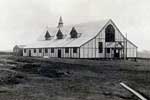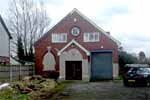For this church:  |
|
 The church at The church at Clipstone Camp |
The Nottingham Journal, reporting on the dedication of the church and workingmens' institute on 1 October 1921, provides a detailed description of the building:
A new mission church—to be known as St. Andrew's—has been erected at the north side of East Kirkby on land presented by the Duke of Portland. The building is one which was in use at Clipstone camp during the war, where it served as a garrison church. The whole cost of removal and re-erection has been borne by the Butterley Co. It is constructed of substantial timber with asbestos and concrete walls, and has been reroofed with asbestos and concrete slates. It is placed upon a brick foundation, a low-pressure hot water heating system installed, and is electrically lighted by power from the colliery. One-third of the building has been partitioned off to form an institute for the Colliery Co.'s workmen, and after class-rooms and vestries have been provided it will still allow seating accommodation for 600 worshippers.
The handsome altar is made from oak grown in Clipstone Forest, and is presented by the Mansfield and district C.E.M.S., together with the Dosel poles and curtains The brass inscription plate is supplied by St. Thomas C.E.M.S. The small stone font and bell, lectern and Bible have come from the parish church, and the organ and chairs are a gift from the diocese of Southwell. The church was dedicated on Saturday afternoon by the Bishop of Southwell. A procession, which included many of the neighbouring clergy, assembled at the parish church and proceeded to escort the Bishop to St Andrews, the Kimberley Colliery prize band leading the way. The directors of the Butterley Co. met the Bishop at the church, and formally presented it to the Bishop, who then dedicated it for public worship.
Kelly's directory (1941) provides a brief description of the post-1932 St Andrew's:
A new church was built in 1932 and is a building of brick, consisting of chancel and nave: there are 180 sittings. The living is a perpetual curacy, net yearly value £271, in the gift of the Crown and the Bishop of Southwell alternately, and held since 1940 by the Rev. Johnston Redmond Th.L.
After the opening of the present brick church on 8 October 1932, the old church was used as a Church Hall, and before the building was taken down in 1947, it was once more used by the army but this time as a billet for soldiers serving in the forces during the 1939-1945 war.
The ecclesiastical district of St Andrew was formed out of the parish of St Thomas in 1933.
St Andrew's church was closed in 1961 and after being used for commercial purposes was partly converted into a house in the 2000s.






